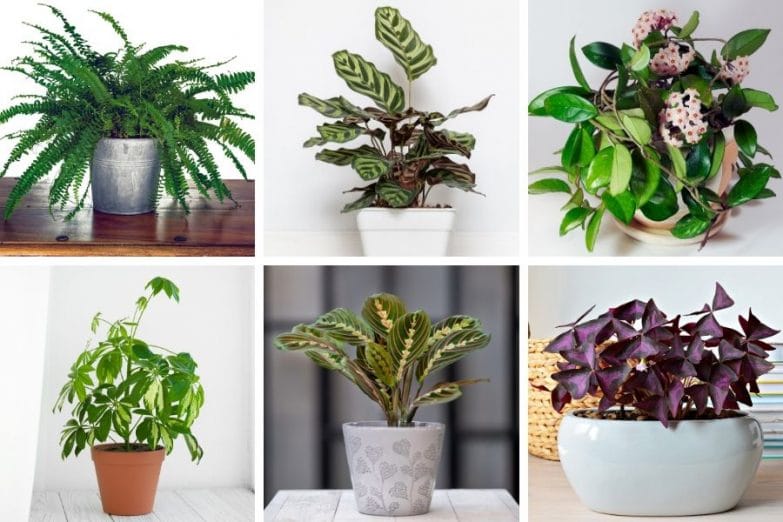East-facing windows are an ideal source of the bright, indirect light favored by some of our most beautiful houseplants. This exposure offers brief hours of morning sunlight before the heat of the day followed by indirect light through the long afternoon. Many desirable tropical plants evolved in the filtered sunshine of a forest canopy and make perfect east facing window plants.
If you’re lucky enough to own such precious real estate, you can grow many stunning and in-demand plants that are otherwise finicky about their light. Let’s take a look at 14 of the best plants for an eastern exposure.
1. Areca palm (Dypsis lutescens)
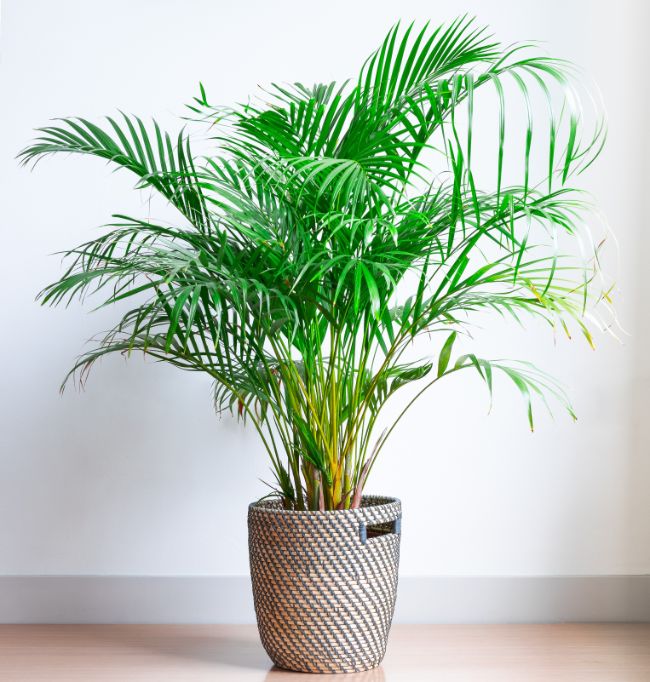
One of the most popular palms grown indoors, the stately Areca palm has an unfortunately difficult reputation. Commonly called Butterfly Palms for their long, feathery fronds, they need bright indirect light to stay healthy and full. Areca palms are perfect east facing window plants, providing them the right stuff to grow into magnificent specimens that reach to the ceiling.
They prefer high humidity but can usually tolerate less; leaf browning is a hint they need extra moisture. With well-draining soil and judicious watering, this plant wards off most pests and diseases. If you do find spider mites—everything seems to get them!—a simple wash with horticultural soap will remove them.
It’s important to avoid drafts and keep their temperatures in a comfortable household range of from 65°F (16°C) to 75°F (24°C). Areca palms are good citizens, too: they’re considered one of the best indoor air-purifying plants, and the ASPCA lists them as non-toxic to cats and dogs. Read my Areca Palm care guide for more information.
2. Japanese fatsia (Fatsia japonica)
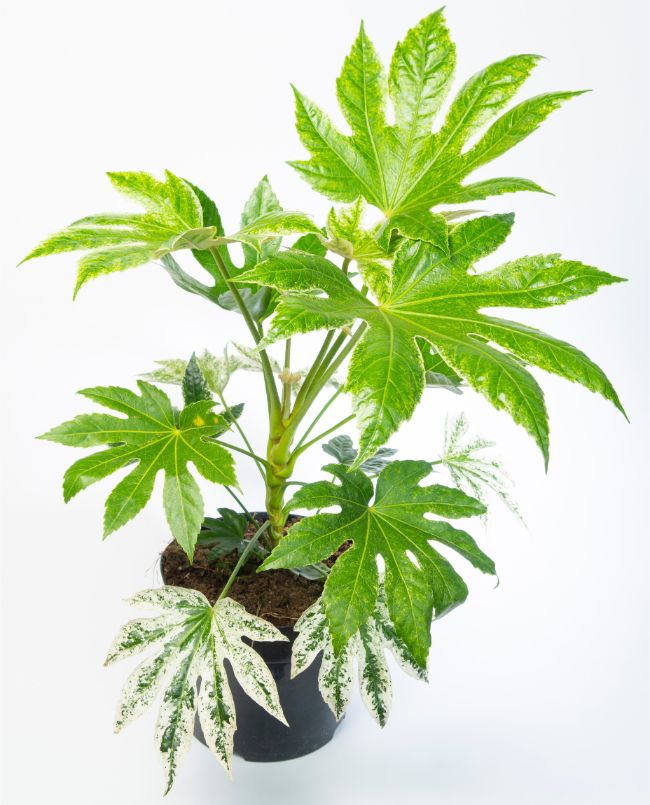
Another space-filling ornamental with impressive foliage, the Japanese fatsia is a shade-loving landscaping shrub that does well inside if given bright conditions away from direct sun. It’s a tall, bushy plant that brings the tropics indoors with bold, deeply-lobed leaves which can reach a foot across. The cultivar Variegata is especially striking.
With morning sun, Fatsia make great east facing window plants, and they are generally easy to maintain. They like consistent moisture in a well-draining soil with light fertilization over the growing season. Otherwise they are mostly unfussy.
Their one persnickety demand is an insistence on having a cool season with overnight temps of 50°F, yet they die off in a freeze. A sheltered porch can do the trick, but be prepared. Their broad, thick leaves can attract the usual company of easily treated aphids, mealy bugs and the like. The plant is non-toxic to pets, though its sap can cause skin irritation.
3. Swiss Cheese Plant (Monstera deliciosa, Monstera adansonii)
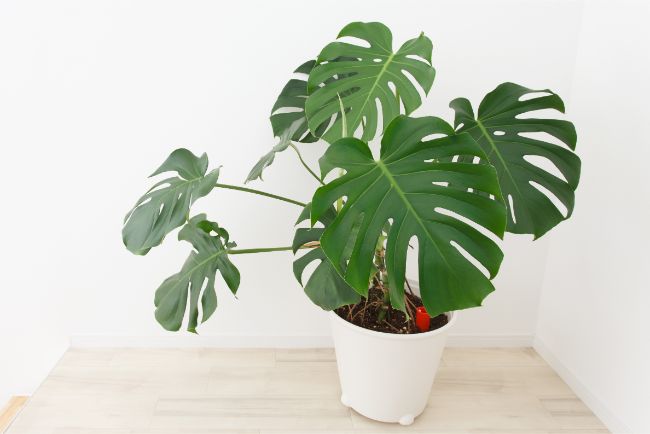
The trend-setting Swiss Cheese Plant is popular indoors for its glossy, fenestrated (hole-y) leaves and vining nature that give it a uniquely tropical look. The two main species grown indoors are the oversized deliciosa and smaller adansonii.
Monsteras won’t look monstrously robust without the right light: thin leaves and skimpy air-roots mean it’s too dim. You can put them right up to your east-facing window: the more bright indirect light they receive the healthier and faster-growing they’ll be. Bright conditions also help develop their striking fenestration.
The other requirement for Monstera success is high humidity. They can get by on misting and water trays, but they really thrive on the steamy conditions a room humidifier creates. They like rich and porous soil, consistent moisture, and room temperatures on the warmer side.
You’ll spot insect infestations early with regular leaf cleaning: pests are easy to remove with a shower followed by a neem oil spray. Their foliage contains calcium oxalates that are toxic to pets. Read everything you need to know about caring for Monstera deliciosa in my guide to monstera care.
4. Fiddle leaf Fig (Ficus lyrata)
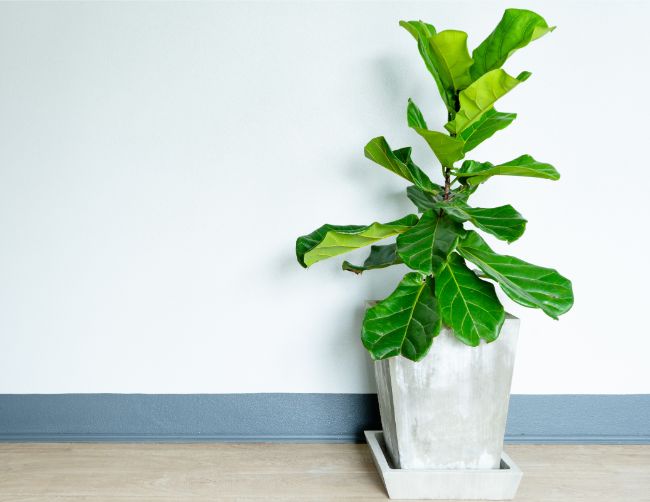
East-facing windows give you an advantage with another incredibly popular plant: the trendy and loveable Fiddleleaf Fig. This chart-topper wants three to four hours of filtered sunlight daily, and morning sun is just right. With this exposure you can avoid the two biggest Fiddleleaf complaints: leaf drop and browning.
Of course, light is just one of the fiddly factors that keep this tropical ephiphyte feeling its best. You’ll also need to beef up the humidity and maintain even moisture in well-draining soil. It likes regular feeding and having its broad leaves cleaned keep them pest-free and breathing. Give the plant room for air circulation away from cold spots or drafts.
Eastern exposure can help you succeed with this in-demand glamor plant not everyone can grow. It has the same unfortunate toxicity to pets as the Monstera.
5. Umbrella Tree (Schefflera)
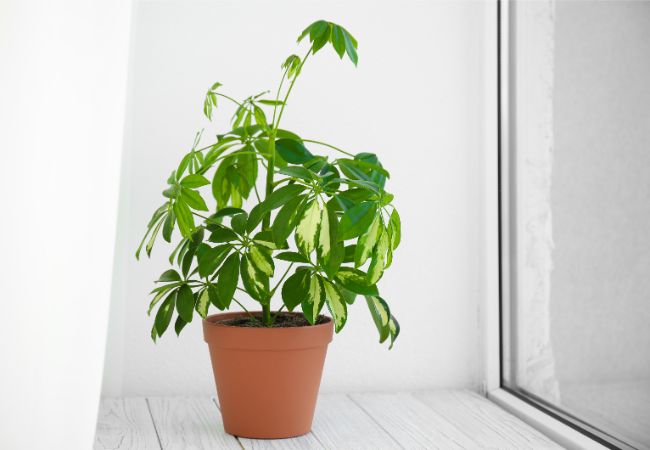
This oldie-but-goody tropical is called the Umbrella Tree for its habit of losing lower leaves until it looks like a tufted palm. You can keep it bushy and full with springtime pruning, but it needs good indirect light to make it happen. Scheffleras handle a range of light conditions except direct sun, but they do best as east facing window plants, becoming downright hardy.
As tropicals, they like high humidity and slightly moist soil; however, they can handle less ideal circumstances and still look good. They are fairly pest-free and only need light monthly feeding. Only repot when they’re rootbound.
Pro Tip: Give them a weighty pot to counterbalance their top-heavy growth.
There’s two popular indoor Schefflera varieties: the large actinophylla with leaves that grow up to a foot long, and a smaller-leaved dwarf named arboricola—which can still reach six feet in height. It’s even versatile enough to make a good bonsai plant. One warning: it is quite toxic if ingested.
6. Hoya Plant (Hoya carnosa)
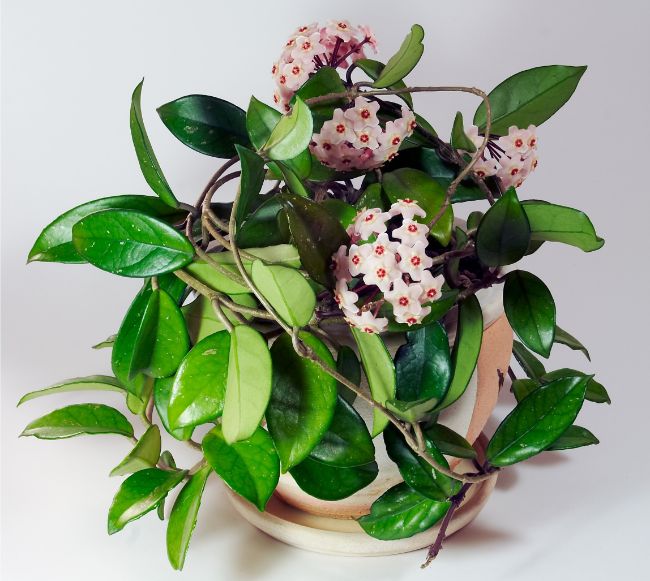
Hoyas are popular tabletop, hanging, or windowsill plants with beautiful foliage, brilliant flowers, and an unfortunate reputation. Some claim they are super-easy to keep, others have (much) less luck: it often comes down to the quality of their light. Hoyas like lots of bright indirect sun, which can be hard to get right—an eastern exposure is an easy solution.
It’s hard to sum up care since there are literally hundreds of varieties: some are more succulent-like and others more tropical. Hoyas tend to want substantial amounts of watering without ever staying wet, and they dislike frequent repotting. Most favor light fertilization … or just a rich organic soil. High humidity is generally preferred, but many manage just fine with less.
If you’ve tried Hoyas before without the success you’d like, you might give them another try in your east-facing window. Their sap can irritate skin, but they aren’t toxic to pets. I’ve written a guide to caring for Hoya carnosa to help you grow a healthy and happy plant.
7. Calathea
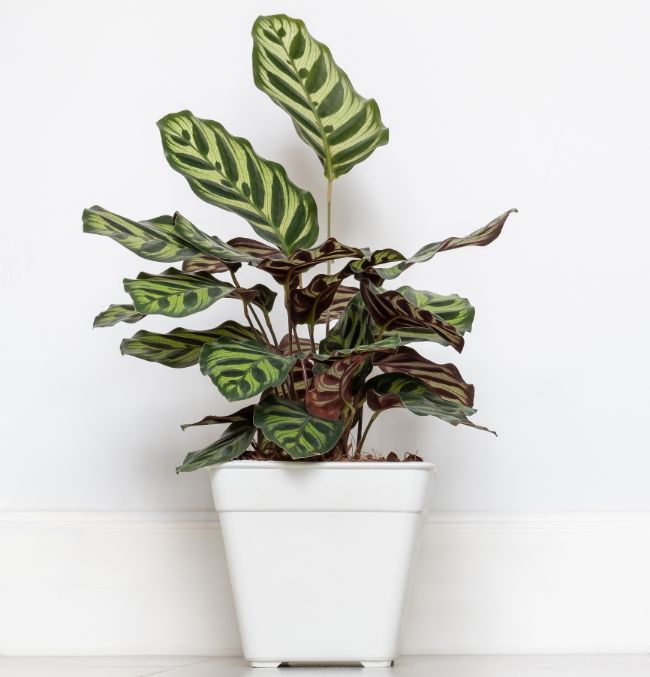
These diverse and collectible tropicals have stunning oblong foliage; unfortunately, most are a little stringent in their demands. Zebra, peacock, and rattlesnake plants are examples of the amazing variety available.
Calatheas make great east facing window plants, preferring the indirect bright light conditions; but, even with the right light, these plants can be high-maintenance. They need regular watering without ever getting soggy … and most need high humidity to really flourish. A room humidifier may be necessary, but you can sometimes get by with water trays and misting. It’s best to use purified, conditioned water to avoid leaf spots.
If you supply these important factors, Calatheas offer some of the most striking tropical foliage in the world … if you don’t, brown spots and crackly edges will soon let you know. Most are considered pet-safe, but there are reports of indigestion.
Read my articles about calathea ornata care and calathea makoyana care for more information about growing these demanding but worthwhile beauties.
8. Prayer plant (Maranta)
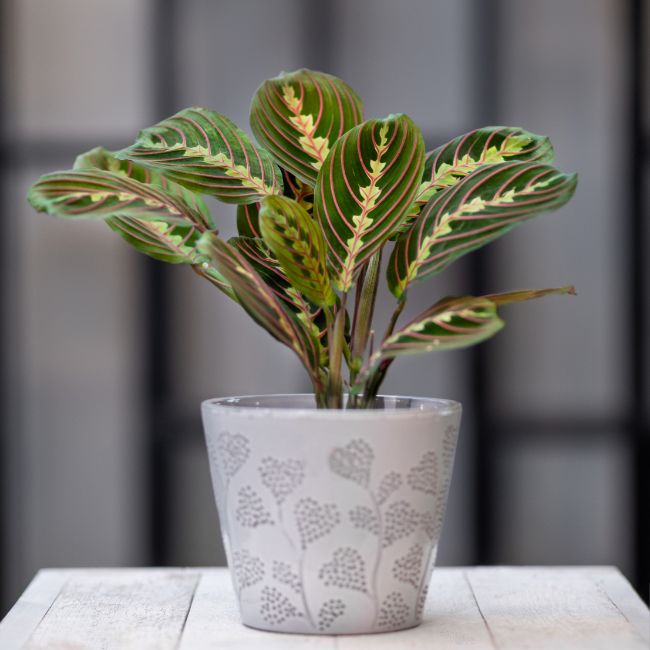
This friendly Calathea deserves special mention because it’s easier to keep than most of that family, commonly available, and incredibly popular. Their beautiful foliage will bleach in the sun and languish in dim conditions, but they thrive in bright indirect light.
There’s more to these plants than strikingly beautiful coloration … they have the interesting behavior of tucking themselves in nightly by folding their leaves to “pray.”
These dynamic plants like humidity but can be satisfied with a pebble-filled water tray. Watering is the trickiest part of their care: they want consistent moisture and don’t handle droughts gracefully, but they get root rot if the soil stays wet. They do best with lukewarm, chlorine-free water.
Less fussy than your typical Calathea, in an east-facing window Prayer Plants can flourish like gorgeous weeds. They are also non-toxic and safe for pets. If you want to get started growing your own, read my prayer plant care guide.
9. Moth Orchid (Phalaenopsis)
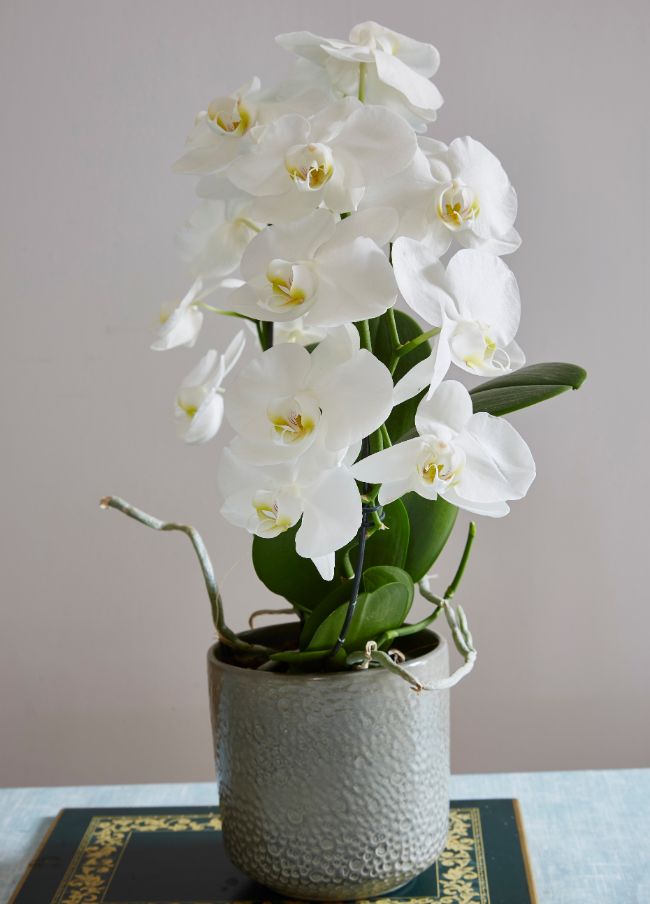
The Moth Orchid is a great beginner’s orchid that’s easy to care for indoors and has delicate, long-lasting blooms. The trick is to give it plenty of brightness without direct sunlight. East-facing windows are the perfect setting.
Phalaenopsis orchids are epiphytes that need the light, airy soil of a good orchid mix. Their roots actually turn colors according to their need for watering: silvery roots means it needs a drink.
When buying a Moth Orchid, make sure its leaves are firm: soft leaves are a sign of unhealthy roots. It’s best to choose a specimen without too many opened buds in order to enjoy months of bloom.
Many people mistakenly think the plant is dying after their blooms expire—but don’t throw them out! You can let your Moth Orchid recharge and have it bloom again for many years.
An east-facing window makes keeping this plant a rewarding horticultural adventure … orchids are an entire world onto themselves. They are non-toxic, too.
Phalaenopsis orchids are one of my favorite indoor plants and I’ve written extensively about them on this site. If you want to get started growing beautiful orchids, try my beginners guide to phalaenopsis orchid care.
10. Flamingo Flower (Anthurium)
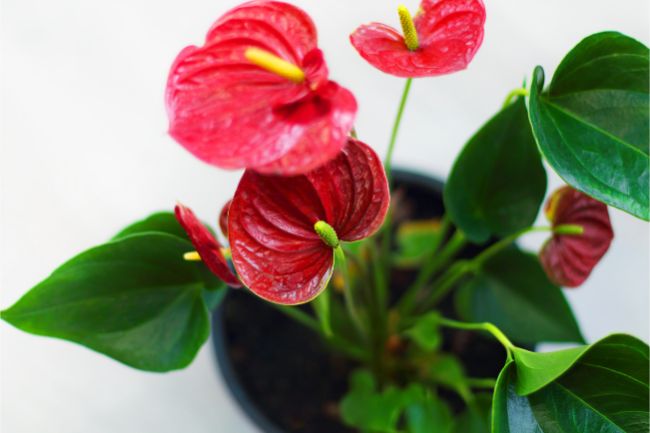
The outstanding features of glossy foliage and vibrant waxy blossoms each make the Anthurium worthwhile – but you get both! They have a reputation for being tricky, but the key to this South American beauty is light from an east-facing window.
Anthuriums have wonderfully textured leaves with lots of character, but they burn easily in direct sun … yet, though they can handle low light, they won’t grow very fast (or at all) in it. With indirect bright light they’ll produce stunning foliage and spathe flowers … and the blooms last for many months. Another bonus: There are a huge number of varieties to choose from.
Problems with Anthuriums usually come from an excess of light or water. They need regular, careful watering and fast-draining soil to avoid root rot and assorted fungal issues.
Pro Tip: Most store-bought plants come in soil that’s too heavy and will require repotting in a lighter mix for long-term success.
Always let the soil dry slightly between waterings. Anthuriums love high humidity, good air circulation, and having their leaves cleaned regularly. They are toxic, though, so keep them off the menu for people and pets. Read more in my anthurium care guide.
11. Flaming Katy )Kalanchoe blossfeldiana)
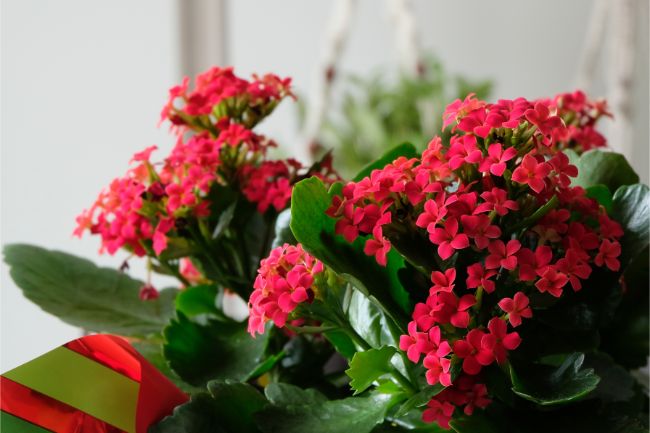
This beautiful flowering succulent does better the more light it has – that is, as long as they are out of direct sun. Commonly called a Flaming Katy, this popular Madagascar native is easy to keep in bloom in an east-facing window. They flower freely in shades of white, yellow, pinks and reds above a nest of dark green foliage.
Kalanchoes are succulents, so avoid overwatering. Give them fast-draining soil and let the top half of the pot dry between waterings. Avoid getting the leaves wet to keep them spot-free. Keep pets away because they are toxic to pets (but not humans).
The Kalanchoe’s vibrant blooms can last for months, and they don’t mind if you clip some foliage away to show them off. You can buy them to enjoy an easy season of bright color—unfortunately, they’re tricky to re-bloom.
They need 12-14 hours of total darkness every day for two months during the cool season to trigger flowering. Some dedicated growers tote them into a closet each night to get the job done … you may want to consider them an annual. Read more about flaming katy care here.
12. Purple Shamrock (Oxalis triangularis)
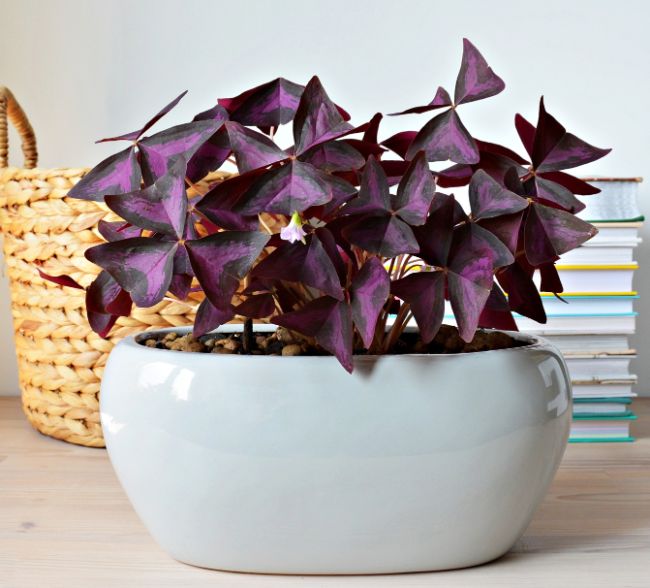
The attractive purple tri-fold foliage of this interesting plant combines the best properties of the live-action Prayer Plant, a lucky shamrock, and the tasty radish. Its leaves and even the trumpet-shaped flowers close up like an umbrella each night. It loves an eastern exposure and royally offsets the brilliant greens of your tropical collection. It deserves space on an east-facing window, where it’s easy to please.
Also called a False Shamrock or Purple Shamrock – it comes from Brazil, not Ireland. Oxalis likes home temps that are slightly on the cooler side. It’s a bulb-type plant that goes dormant after temps reach above 80°F (27°C); they can sporadically cycle indoors. The leaves decline during dormancy, but the plant comes back in just 2-4 weeks.
Overwatering is the main danger, so you should let the topsoil dry out between waterings and cut back during dormancy. Oxalis is happily unparticular about humidity. It does well with light fertilization every two weeks during its growing period.
The long-lived Oxalis is often passed down as an heirloom. They are fun to watch fold up in the evenings, and they produce cheery white or pink blossoms all summer. If it overgrows its welcome, you can always pop it into a salad. Read my guide and watch my video about caring for oxalis triangularis.
13. Peperomia
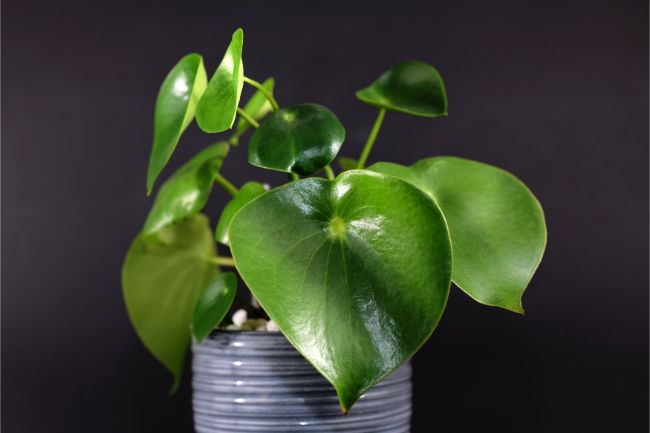
The trendy Peperomia has sparked a wave of tiny plant love across Instagram … but they’ve broken the hearts of many who’ve treated it like sun-loving green babies. Peperomias like bright light, but they also burn easily. They can do well under fluorescent lighting, making them champion office plants, but they become dull slow-growers in light that’s too dim. An eastern exposure is just right.
They are grown for their fleshy succulent leaves which come in a myriad of variations. This, along with their small size, makes them prime collectibles. To understand one Peperomia is to understand them all (almost). Visualize them as tiny Hoyas.
Most Peperomias are ephiphytes that like light, fast-draining soil. Let them dry out a bit between waterings to avoid pests and fungal problems. Their humidity needs are usually satisfied with misting and/or a pebble-filled water tray. You can fertilize them during the growing season for faster growth, but it’s not required.
If you’d like to learn more about peperomia plants and how to keep them looking their best, read my article that will get you completely up to speed.
14. Boston Fern (Nephrolepis exaltata)
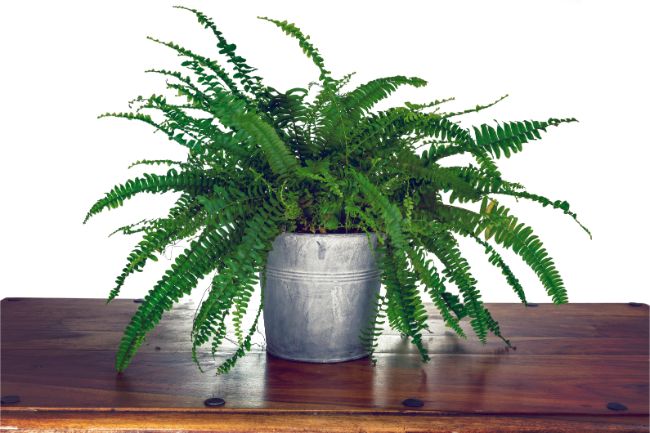
This fern classic has gone in and out of fashion since Victorian times: its green arching glory made Fern Bars the go-to spot in the ’80s before they crashed back into horticultural disfavor. For many, the key word for ferns is frustration—insistence by experts of how “easy” they are has triggered more than one exasperated owner to express their feelings with a trashcan or compost pile.
Boston ferns are perfect east facing window plants so if you have an available windowsill, you should give these evergreen wonders another try. You can have success with Boston Ferns, or almost any ferns, if you give them lovely bright light that never burns.
They originate as swamp plants and like humidity and well-draining soil that holds moisture without sogginess. Let their topsoil dry out just slightly between waterings. Don’t fertilize too much, and groom the dead leaves as you see them.
Boston Ferns love air circulation and do best as hanging plants. The light factor matters, though: if all you have is a blazing hot western or southern exposure, don’t put them and yourself through it. They are happily non-toxic for pets.

